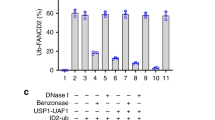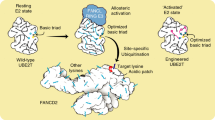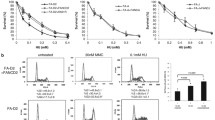Abstract
Fanconi anemia (FA) is a rare cancer-predisposing genetic disease mostly caused by improper regulation of the monoubiquitination of Fanconi anemia complementation group D2 (FANCD2). Genetic studies have indicated that ubiquitin conjugating enzyme UBE2T and HHR6 could regulate FANCD2 monoubiquitination through distinct mechanisms. However, the exact regulation mechanisms of FANCD2 monoubiquitination in response to different DNA damages remain unclear. Here we report that UBE2W, a new ubiquitin conjugating enzyme, could regulate FANCD2 monoubiquitination by mechanisms different from UBE2T or HHR6. Indeed, UBE2W exhibits ubiquitin conjugating enzyme activity and catalyzes the monoubiquitination of PHD domain of Fanconi anemia complementation group L (FANCL) in vitro. UBE2W binds to FANCL, and the PHD domain is both necessary and sufficient for this interaction in mammalian cells. In addition, over-expression of UBE2W in cells promotes the monoubiquitination of FANCD2 and down-regulated UBE2W markedly reduces the UV irradiation-induced but not MMC-induced FANCD2 monoubiquitination. These results indicate that UBE2W regulates FANCD2 monoubiquitination by mechanisms different from UBE2T and HRR6. It may provide an additional regulatory step in the activation of the FA pathway.
Similar content being viewed by others
References
Alpi, A., Langevin, F., Mosedale, G., Machida, Y.J., Dutta, A., and Patel, K.J. (2007). UBE2T, the Fanconi anemia core complex, and FANCD2 are recruited independently to chromatin: a basis for the regulation of FANCD2 monoubiquitination. Mol. Cell. Biol. 27, 8421–8430.
Alpi, A.F., Pace, P.E., Babu, M.M., and Patel, K.J. (2008). Mechanistic insight into site-restricted monoubiquitination of FANCD2 by Ube2t, FANCL, and FANCI. Mol. Cell 32, 767–777.
Auerbach, A.D. (1988). A test for Fanconi’s anemia. Blood 72, 366–367.
Bagby, G.C., Jr. (2003). Genetic basis of Fanconi anemia. Curr. Opin. Hematol. 10, 68–76.
Chen, Z.J. (2005). Ubiquitin signalling in the NF-kappaB pathway. Nat. Cell Biol. 7, 758–765.
Christensen, D.E., Brzovic, P.S., and Klevit, R.E. (2007). E2-BRCA1 RING interactions dictate synthesis of mono- or specific polyubiquitin chain linkages. Nat. Struct. Mol. Biol. 14, 941–948.
Cook, W.J., Jeffrey, L.C., Sullivan, M.L., and Vierstra, R.D. (1992). Three-dimensional structure of a ubiquitin-conjugating enzyme (E2). J. Biol. Chem. 267, 15116–15121.
Cook, W.J., Jeffrey, L.C., Xu, Y., and Chau, V. (1993). Tertiary structures of class I ubiquitin-conjugating enzymes are highly conserved: crystal structure of yeast Ubc4. Biochemistry 32, 13809–13817.
Coscoy, L., and Ganem, D. (2003). PHD domains and E3 ubiquitin ligases: viruses make the connection. Trends Cell Biol. 13, 7–12.
D’Andrea, A.D., and Grompe, M. (2003). The Fanconi anaemia/BRCA pathway. Nat. Rev. Cancer 3, 23–34.
de Lima-Bessa, K.M., Armelini, M.G., Chigancas, V., Jacysyn, J.F., Amarante-Mendes, G.P., Sarasin, A., and Menck, C.F. (2008). CPDs and 6-4PPs play different roles in UV-induced cell death in normal and NER-deficient human cells. DNA Repair 7, 303–312.
Dodd, R.B., Allen, M.D., Brown, S.E., Sanderson, C.M., Duncan, L.M., Lehner, P.J., Bycroft, M., and Read, R.J. (2004). Solution structure of the Kaposi’s sarcoma-associated herpesvirus K3 Nterminal domain reveals a Novel E2-binding C4HC3-type RING domain. J. Biol. Chem. 279, 53840–53847.
Dorsman, J.C., Levitus, M., Rockx, D., Rooimans, M.A., Oostra, A.B., Haitjema, A., Bakker, S.T., Steltenpool, J., Schuler, D., Mohan, S., et al. (2007). Identification of the Fanconi anemia complementation group I gene, FANCI. Cell Oncol. 29, 211–218.
Garcia-Higuera, I., Taniguchi, T., Ganesan, S., Meyn, M.S., Timmers, C., Hejna, J., Grompe, M., and D’Andrea, A.D. (2001). Interaction of the Fanconi anemia proteins and BRCA1 in a common pathway. Mol. Cell 7, 249–262.
German, J., Schonberg, S., Caskie, S., Warburton, D., Falk, C., and Ray, J.H. (1987). A test for Fanconi’s anemia. Blood 69, 1637–1641.
Grompe, M., and van de Vrugt, H. (2007). The Fanconi family adds a fraternal twin. Dev. Cell 12, 661–662.
Gurtan, A.M., Stuckert, P., and D’Andrea, A.D. (2006). The WD40 repeats of FANCL are required for Fanconi anemia core complex assembly. J. Biol. Chem. 281, 10896–10905.
Hershko, A., Ciechanover, A., and Varshavsky, A. (2000). Basic Medical Research Award. The ubiquitin system. Nat. Med. 6, 1073–1081.
Hu, C.D., and Kerppola, T.K. (2003). Simultaneous visualization of multiple protein interactions in living cells using multicolor fluorescence complementation analysis. Nat. Biotechnol. 21, 539–545.
Hu, C.D., Chinenov, Y., and Kerppola, T.K. (2002). Visualization of interactions among bZIP and Rel family proteins in living cells using bimolecular fluorescence complementation. Mol. Cell 9, 789–798.
Huang, T.T., and D’Andrea, A.D. (2006). Regulation of DNA repair by ubiquitylation. Nat. Rev. 7, 323–334.
Ishiai, M., Kitao, H., Smogorzewska, A., Tomida, J., Kinomura, A., Uchida, E., Saberi, A., Kinoshita, E., Kinoshita-Kikuta, E., Koike, T., et al. (2008). FANCI phosphorylation functions as a molecular switch to turn on the Fanconi anemia pathway. Nat. Struct. Mol. Biol. 15, 1138–1146.
Kaiser, P., Mandl, S., Schweiger, M., and Schneider, R. (1995). Characterization of functionally independent domains in the human ubiquitin conjugating enzyme UbcH2. FEBS Lett. 377, 193–196.
Longerich, S., San Filippo, J., Liu, D., and Sung, P. (2009). Fanci binds branched DNA and is mono-ubiquitinated by UBE2TFANCL. J. Biol. Chem. 284, 23182–23186.
Lu, B., and Bishop, C.E. (2003). Mouse GGN1 and GGN3, two germ cell-specific proteins from the single gene Ggn, interact with mouse POG and play a role in spermatogenesis. J. Biol. Chem. 278, 16289–16296.
Machida, Y.J., Machida, Y., Chen, Y., Gurtan, A.M., Kupfer, G.M., D’Andrea, A.D., and Dutta, A. (2006). UBE2T is the E2 in the Fanconi anemia pathway and undergoes negative autoregulation. Mol. Cell 23, 589–596.
Meetei, A.R., de Winter, J.P., Medhurst, A.L., Wallisch, M., Waisfisz, Q., van de Vrugt, H.J., Oostra, A.B., Yan, Z., Ling, C., Bishop, C.E., et al. (2003). A novel ubiquitin ligase is deficient in Fanconi anemia. Nat. Genet. 35, 165–170.
Meetei, A.R., Levitus, M., Xue, Y., Medhurst, A.L., Zwaan, M., Ling, C., Rooimans, M.A., Bier, P., Hoatlin, M., Pals, G., et al. (2004). X-linked inheritance of Fanconi anemia complementation group B. Nat. Genet. 36, 1219–1224.
Meijer, G.A. (2007). The 13th Fanconi anemia gene identified: FANCI-importance of the ‘Fanconi anemia pathway’ for cellular oncology. Cell Oncol. 29, 181–182
Nakanishi, K., Yang, Y.G., Pierce, A.J., Taniguchi, T., Digweed, M., D’Andrea, A.D., Wang, Z.Q., and Jasin, M. (2005). Human Fanconi anemia monoubiquitination pathway promotes homologous DNA repair. Proc. Natl. Acad. Sci. USA 102, 1110–1115.
Ozkan, E., Yu, H., and Deisenhofer, J. (2005). Mechanistic insight into the allosteric activation of a ubiquitin-conjugating enzyme by RING-type ubiquitin ligases. Proc. Natl. Acad. Sci. USA 102, 18890–18895.
Plans, V., Scheper, J., Soler, M., Loukili, N., Okano, Y., and Thomson, T.M. (2006) The RING finger protein RNF8 recruits UBC13 for lysine 63-based self polyubiquitylation. Journal of cellular biochemistry 97, 572–582.
Poll, E.H., Arwert, F., Joenje, H., and Wanamarta, A.H. (1985). Differential sensitivity of Fanconi anaemia lymphocytes to the clastogenic action of cis-diamminedichloroplatinum (II) and trans-diamminedichloroplatinum (II). Hum. Genet. 71, 206–210.
Robinson, P.A., and Ardley, H.C. (2004). Ubiquitin-protein ligases. J. Cell Sci. 117, 5191–5194.
Seufert, W., and Jentsch, S. (1990). Ubiquitin-conjugating enzymes UBC4 and UBC5 mediate selective degradation of short-lived and abnormal proteins. EMBO. J. 9, 543–550.
Sims, A.E., Spiteri, E., Sims, R.J., 3rd, Arita, A.G., Lach, F.P., Landers, T., Wurm, M., Freund, M., Neveling, K., Hanenberg, H., et al. (2007). FANCI is a second monoubiquitinated member of the Fanconi anemia pathway. Nat. Struct. Mol. Biol. 14, 564–567.
Smogorzewska, A., Matsuoka, S., Vinciguerra, P., McDonald, E.R., 3rd, Hurov, K.E., Luo, J., Ballif, B.A., Gygi, S.P., Hofmann, K., D’Andrea, A.D., et al. (2007). Identification of the FANCI protein, a monoubiquitinated FANCD2 paralog required for DNA repair. Cell 129, 289–301.
Talwar, R., Choudhry, V.P., and Kucheria, K. (2004). Differentiation of Fanconi anemia from idiopathic aplastic anemia by induced chromosomal breakage study using mitomycin-C (MMC). Indian Pediatr. 41, 473–477.
Taniguchi, T., and D’Andrea, A.D. (2006). Molecular pathogenesis of Fanconi anemia: recent progress. Blood 107, 4223–4233.
Taniguchi, T., Garcia-Higuera, I., Andreassen, P.R., Gregory, R.C., Grompe, M., and D’Andrea, A.D. (2002). S-phase-specific interaction of the Fanconi anemia protein, FANCD2, with BRCA1 and RAD51. Blood 100, 2414–2420.
Yin, G., Ji, C., Wu, T., Shen, Z., Xu, X., Xie, Y., and Mao, Y. (2006). Cloning, characterization and subcellular localization of a gene encoding a human ubiquitin-conjugating enzyme (E2) homologous to the Arabidopsis thaliana UBC-16 gene product. Front Biosci. 11, 1500–1507.
Yuan, F., El Hokayem, J., Zhou, W., and Zhang, Y. (2009). FANCI protein binds to DNA and interacts with FANCD2 to recognize branched structures. J. Biol. Chem. 284, 24443–24452.
Zhang, M., Windheim, M., Roe, S.M., Peggie, M., Cohen, P., Prodromou, C., and Pearl, L.H. (2005). Chaperoned ubiquitylation—crystal structures of the CHIP U box E3 ubiquitin ligase and a CHIP-Ubc13-Uev1a complex. Mol. Cell 20, 525–538.
Zhang, J., Zhao, D., Wang, H., Lin, C.J., and Fei, P. (2008a). FANCD2 monoubiquitination provides a link between the HHR6 and FABRCA pathways. Cell Cycle 7, 407–413.
Zhang, Y., Li, C., Yang, Z., Xu, L., Zhu, H., Zhou, X., and Huang, P. (2008b). Selecting functional siRNA target sites of hUBE2W based on H1-U6 dual promoter RNAi plasmid. Sheng wu gong cheng xue bao = Chin. J. Biotechnol. 24, 1975–1980.
Zhang, Y., Zhu, H., Zhao, L., Zhou, X., and Huang, P. (2008c). Generation of mouse UBE2W antibody and analysis of UBE2W expression in mouse tissues. Chin. J. Biotechnol. 24, 547–552.
Zheng, N., Wang, P., Jeffrey, P.D., and Pavletich, N.P. (2000). Structure of a c-Cbl-UbcH7 complex: RING domain function in ubiquitin-protein ligases. Cell 102, 533–539.
Author information
Authors and Affiliations
Corresponding author
About this article
Cite this article
Zhang, Y., Zhou, X., Zhao, L. et al. UBE2W interacts with FANCL and regulates the monoubiquitination of fanconi anemia protein FANCD2. Mol Cells 31, 113–122 (2011). https://doi.org/10.1007/s10059-011-0015-9
Received:
Revised:
Accepted:
Published:
Issue Date:
DOI: https://doi.org/10.1007/s10059-011-0015-9




